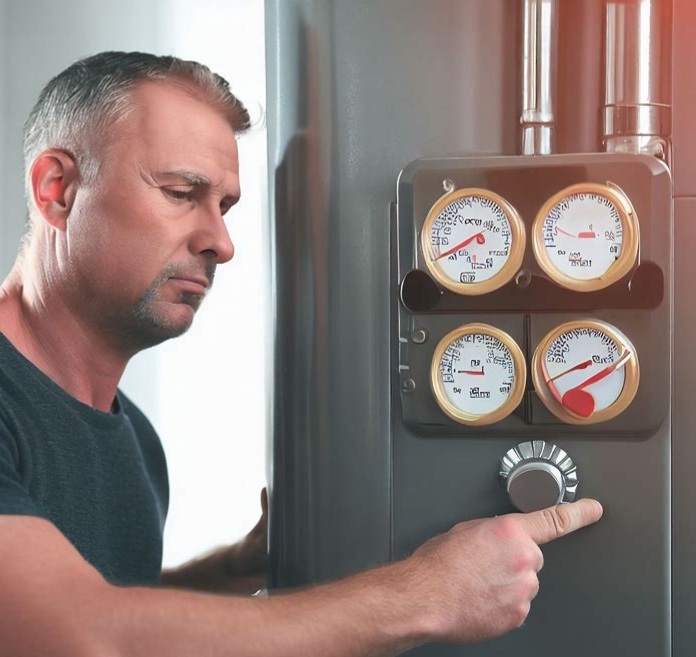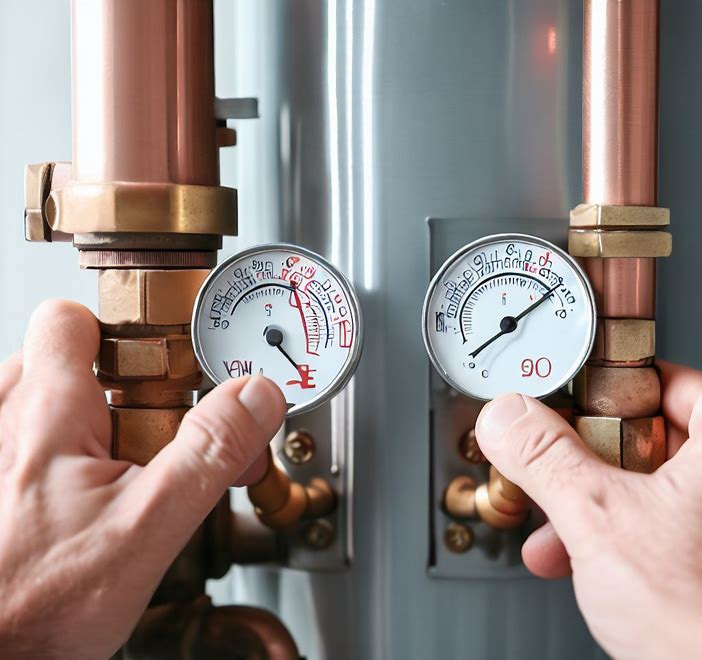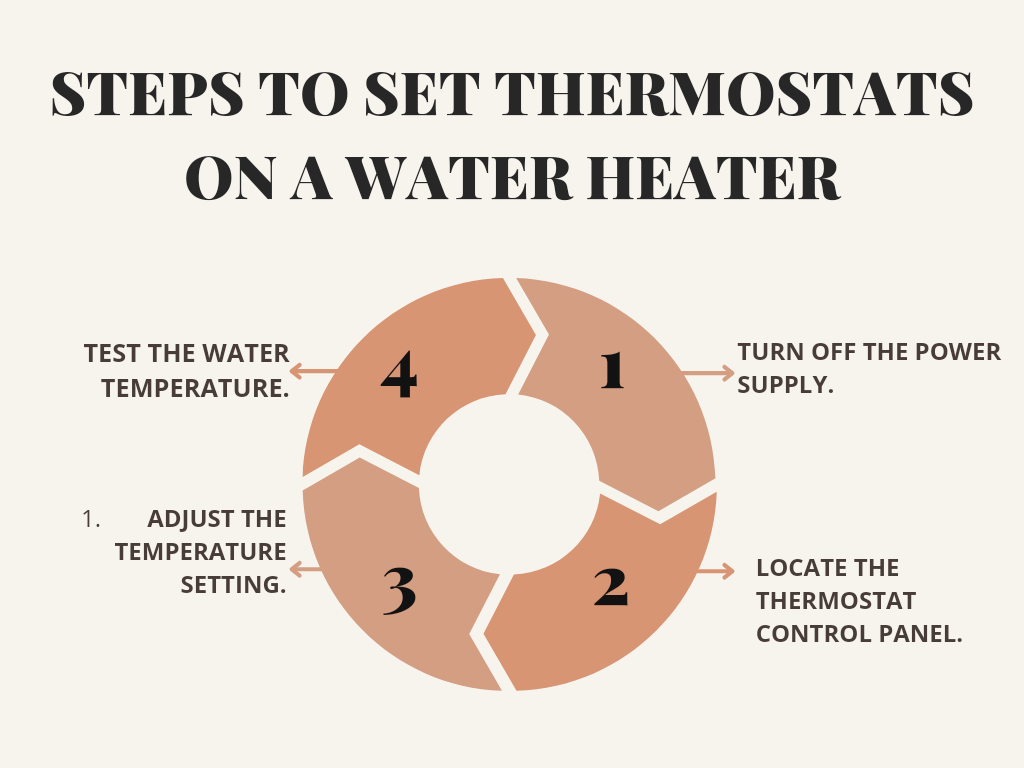Table of Contents
Thermostats are key for keeping hot water heater temps steady. But should both thermostats be the same? Let’s find out!

Key Takeaways
- It is generally recommended to set both thermostats on a water heater to the same temperature for optimal performance and energy efficiency.
- Setting both thermostats to the same temperature ensures that both heating elements are working together to maintain a consistent temperature throughout the tank.
- If the thermostats are set at different temperatures, it can lead to uneven heating and potentially result in one heating element working harder than the other, leading to increased energy consumption and potential damage to the water heater.
- In some cases, having different temperature settings on the thermostats may be necessary, such as when using a water heater with a dual heating element system or when specific temperature requirements are needed for different purposes (e.g., higher temperature for dishwasher or laundry).
- However, it is important to consult the manufacturer’s guidelines or seek professional advice before adjusting the thermostat settings to ensure proper functioning and avoid any potential issues.
It’s usually best to set both thermostats the same. This makes sure both top and bottom of the tank heat up even, for steady hot water in your home. Plus, it reduces risk of scalding accidents from hot water.
Water heaters have two thermostats ’cause they have two heating elements – one at the top and one at the bottom. Each thermostat controls the temp for its element.
A friend of mine once had an adventure with his water heater. He unknowingly set the top thermostat too high. This caused unequal heated water in his tank. So, he got some unexpectedly hot showers, followed by blasts of cold water.
To avoid this, make sure both thermostats on your water heater are the same. You can do this by accessing the control panel or access panel. Then, use a screwdriver or dial to adjust.
Think thermostats on a water heater are just decoration? You’re in hot water!
Understanding the Thermostats on a Water Heater

To understand the thermostats on a water heater, let me explain the top and bottom thermostats. The top thermostat controls the upper part of the tank while the bottom thermostat controls the lower part. Each has its own temperature setting and serves a specific purpose.
Explanation of the Top and Bottom Thermostats
The thermostats on a water heater regulate the temperature of the water in the tank. There are two types: top and bottom. The top thermostat controls the overall temperature, while the bottom thermostat heats the water at the bottom.
| Thermostat Position | Purpose | Function |
|---|---|---|
| Top | Overall Temp Control | Regulates temperature for entire tank |
| Bottom | Heating Water Bottom | Heats water specifically at bottom of tank |
The top thermostat keeps the water evenly heated and maintains the desired temperature. The bottom thermostat focuses on heating cold water that enters the tank. Some manufacturers use one thermostat, while others have both. HomeServe USA suggests setting the top thermostat slightly higher than the bottom one. This prevents overheating and optimizes energy efficiency. Keep the thermostats in sync to get the best results!
Should Both Thermostats on Water Heater Be Set the Same?
To ensure proper functioning of your water heater, it is crucial to set both thermostats to the same temperature. Let’s explore the reasons behind this and understand the importance of maintaining uniform temperature settings. In the following sub-sections, we will discuss the significance of setting the same temperature and the reasons that may arise for setting different temperatures.
Importance of Setting the Same Temperature
Why settle for lukewarm debates? Heat up the discussion about setting thermostats on water heaters!
Setting the same temp on both is crucial. It keeps water safe and consistent. That’s especially important with multiple showers and taps in a house. Plus, it’s energy efficient. The heater won’t have to work hard to balance out different temps. And it avoids scalding accidents. So, keep temps consistent for safety and energy savings!
Reasons for Setting Different Temperatures
Different temperatures on both thermostats of a water heater have several uses. These include:
- Comfort and convenience: Each individual can adjust their thermostat as they like.
- Energy efficiency: Lowering one thermostat consumes less energy when not in use, helping to reduce energy usage.
- Prevention of scalding accidents: Higher temperature on one thermostat provides hot water, while the other thermostat at a lower temperature prevents burns.
- Reduction in energy costs: Lowering the thermostats increases the water heater’s efficiency, resulting in reduced energy bills.
Setting separate temperatures extends the lifespan of the water heater. This concept dates back to the early 1960s when water heaters advanced and dual thermostats were introduced to provide customizable heating options.
Setting different temperatures offers flexibility, energy savings, safety, and has been around for over 60 years. Don’t worry, it’s not as complicated as a Facebook relationship status!
Steps to Set the Thermostats on a Water Heater

To set the thermostats on your water heater properly, follow these steps: Turn off the power supply, locate the thermostat control panel, adjust the temperature settings, and test the water temperature. Each step will guide you through the process of effectively managing the temperature of your water heater for optimal comfort and safety. By following these steps, you can ensure that your water heater operates efficiently while providing hot water at the desired temperature.
Turn off the Power Supply
Cutting off the electricity to your water heater is a must for safety. Flip the switch labeled “water heater” or something similar. You’ll hear a click to confirm it’s been turned off. Test it by turning on a hot water faucet – no hot water? You’re safe!
Still, take precautions. Treat it as if it’s still powered and protect yourself with gear. Your owner’s manual may have extra instructions.
Never skip this important step. Put safety first by shutting off the power supply before messing with the water heater. Your safety is priceless!
Locate the Thermostat Control Panel
Identifying the thermostat control panel on your water heater is essential for efficient maintenance. It’s usually located near the bottom or middle section of the tank. Look for a small access door or removable panel on the exterior of the casing. Carefully remove it using a screwdriver or other appropriate tool. Make sure your water heater is completely turned off first.
Plus, some newer models may have digital displays or touchscreens instead of physical dials. Get to know these features to adjust the temperature settings correctly.
Did you know? In the past, water heaters didn’t have easily accessible thermostat control panels. People had to use manual methods like gas valves or trial and error to set the desired water temperature. Thermostats revolutionized water heating systems by giving users more precise control.
Tinkering with the temperature settings on a water heater isn’t fun. It’s like choosing your own level of torture in a sauna!
Adjust the Temperature Settings
It’s easy to alter the temperature settings on your water heater. It’s essential to adjust them for comfort and efficiency. Here’s your step-by-step guide:
- Spot the thermostat. It’s usually on the front of the heater, near the bottom. It may be covered or labeled with temperature markers.
- Switch off the power. Flip the circuit breaker in your electrical panel.
- Take off the cover. Use a screwdriver or any suitable tool. Be careful not to damage any components.
- Adjust the temperature. Rotate the thermostat to your desired temperature. Most thermostats go from 90°F (32°C) to 160°F (71°C).
- Test and check. After setting the desired temperature, turn on the power. Make sure the water heater reaches and maintains the selected temperature.
It’s wise to set the temperature between 120°F (49°C) and 140°F (60°C). Consult your manufacturer’s instructions for specific guidance.
In the past, you needed to hire a professional technician to make changes to the thermostat. Now, modern water heaters are user-friendly, so you can customize your water heating experience. Just make sure not to burn or freeze yourself!
Test the Water Temperature
Testing your water heater’s temperature is essential for optimal performance and safety. Here are the steps to accurately assess the temp and make adjustments:
- Turn off hot water in the house. Wait a few hours for the tank to heat up.
- Locate the temperature dial near the bottom of unit.
- Use a reliable thermometer on the hot water coming out of a faucet. Let it run for a few minutes.
- Compare thermometer reading to dial setting. If there’s a difference, adjust accordingly.
- To lower, turn dial to lower setting; to raise, turn to higher setting.
- Repeat until you reach desired, safe temp.
Note: High temp can lead to scalding or plumbing damage. Best to set heater at 120°F (49°C).
Optimizing Results:
- Install a mixing valve if you have young kids or elderly people in the house, for hot water safety.
- Regular maintenance is essential. Flush sediment buildup to prevent overheating and inaccurate readings.
By testing and adjusting your water heater regularly, you’ll enjoy not only comfort but safety in your home.
The Proper Way to Use and Maintain Water Heater Thermostats
To ensure optimal performance and safety of your water heater, it is crucial to know the proper way to use and maintain its thermostats. In this guide, we will delve into the necessary steps to follow while exploring safety tips and how to check for any potential issues. By understanding and implementing these guidelines, you can ensure the efficient operation and longevity of your water heater system.
Safety Tips
Check and maintain the water heater thermostat regularly to avoid malfunctions or accidents. Inspect electrical connections for damage or loose wires. Keep flammable items away from the heater to prevent fires. Be cautious when adjusting the thermostat temperature and always follow the manufacturer’s instructions. If you smell or hear something unusual, turn off the heater and get a professional right away. Also, know the emergency shut-off procedure in case of a problem.
Never try to repair or replace thermostat parts without the right knowledge and training. Always hire a licensed professional for such tasks.
My friend once disregarded a strange smell from their water heater, which caused a small fire due to a faulty thermostat. But they swiftly activated the emergency shut-off and called a technician, preventing further harm. This serves as a reminder to prioritize safety measures when using and maintaining water heater thermostats. Whenever it gets too hot, it’s time to adjust things!
Checking for Issues
Inspecting your water heater is essential for it to keep functioning and last. Here are some points to consider:
- Look at the pilot light: A yellow or flickering flame means a gas flow problem. It should be blue and still.
- Check for leaks: See if any connections, valves, or pipes are leaking. Even a small drip can mean a bigger problem.
- Monitor temperature: Unstable water temperatures could mean a faulty thermostat. Change it carefully, so you don’t get scalded or cold showers.
- Test pressure relief valve: Lift the lever halfway and let go. If it doesn’t release water, it’s not working.
- Listen for unusual sounds: Rumbling or banging might be sediment buildup or other issues.
Other details to note:
- Check for rust or corrosion on the exterior, which could mean leakage or structure problems.
- Be careful with electrical parts, they can be dangerous.
- Note any bad smells, which may be bacteria inside the tank.
An experienced plumber’s story:
I once found an unexpected issue during a check-up. I smelled something weird and realized the homeowners had put food debris near the heater. This caused bacteria to grow inside the tank, making the hot water stinky. After cleaning and sanitizing, the issue was fixed.
Regular inspections can stop minor issues from becoming big ones and save you money. Be proactive and maintain your water heater!
Frequently Asked Questions
Should Both Thermostats on Water Heater Be Set the Same?
Yes, both thermostats on a water heater should be set to the same temperature. This ensures even heating throughout the tank and prevents one thermostat from working harder than the other.
Why Do Water Heaters Have Two Thermostats?
Water heaters have two thermostats to regulate the temperature of the water in the tank. The top thermostat controls the upper part of the tank, while the bottom thermostat controls the lower part. This allows for more efficient heating and maintains the desired temperature throughout the tank.
Should Water Heater Thermostats Be Set to the Same Temperature?
Yes, it is recommended to set both water heater thermostats to the same temperature. This ensures uniform heating and prevents the risk of scalding if the temperature is set too high. It also helps maintain a consistent supply of hot water for your needs.
What Temperature Should I Set the Water Heater Thermostat?
The temperature setting for your water heater thermostat should be around 120 degrees Fahrenheit (49 degrees Celsius). This is a moderate temperature that balances comfort and safety. However, you should consult your water heater manufacturer’s recommendations as some may have specific guidelines.
How Do I Set the Temperature on the Water Heater Thermostat?
To set the temperature on the water heater thermostat, follow these steps:
- Locate the access panel on your water heater.
- Remove the panel using a screwdriver.
- Look for the temperature dials or indicators on the thermostats.
- Adjust the temperature using a flathead screwdriver. Turn it clockwise to increase the temperature and counterclockwise to decrease it.
- Make small adjustments and wait for at least a few hours to see the effects before making further changes.
- Replace the access panel and ensure it is secured properly.
Why is it important to set the water heater thermostats to the same temperature?
Setting the water heater thermostats to the same temperature is important for maintaining a balanced and efficient heating system. If the thermostats are set to different temperatures, the water heater may consume more energy, experience uneven heating, and result in inconsistent hot water supply. By setting them to the same temperature, you can optimize energy usage and ensure a consistent hot water temperature throughout your home.
Conclusion
It is vital to set both thermostats on a water heater to the same temperature. Doing this ensures the tank is heated evenly and efficiently. It also reduces the risk of scalding. Plus, it promotes energy savings.
The top and bottom heating elements work together when the thermostats are set at the same temperature. This ensures a consistent supply of hot water throughout the tank. Additionally, setting the thermostats at a moderate temperature can protect against scalding, especially in households with children or elderly people.
Having both thermostats set to the same temperature also saves energy. When the top thermostat senses the water has reached the desired temperature, it turns off the top heating element. If the temperature between the top and bottom of the tank varies significantly, it causes the heating elements to cycle unnecessarily, wasting energy and raising electricity bills.
Setting both thermostats to an optimal temperature not only helps with efficient heating but also prevents Legionella bacteria growth. Legionellae thrives in temperatures between 20°C (68°F) to 50°C (122°F). Setting your water heater’s thermostat above 60°C (140°F) reduces the risk of bacteria growth, providing extra safety for your family.
References :
Should water heater thermostats be set to the same temperature?
